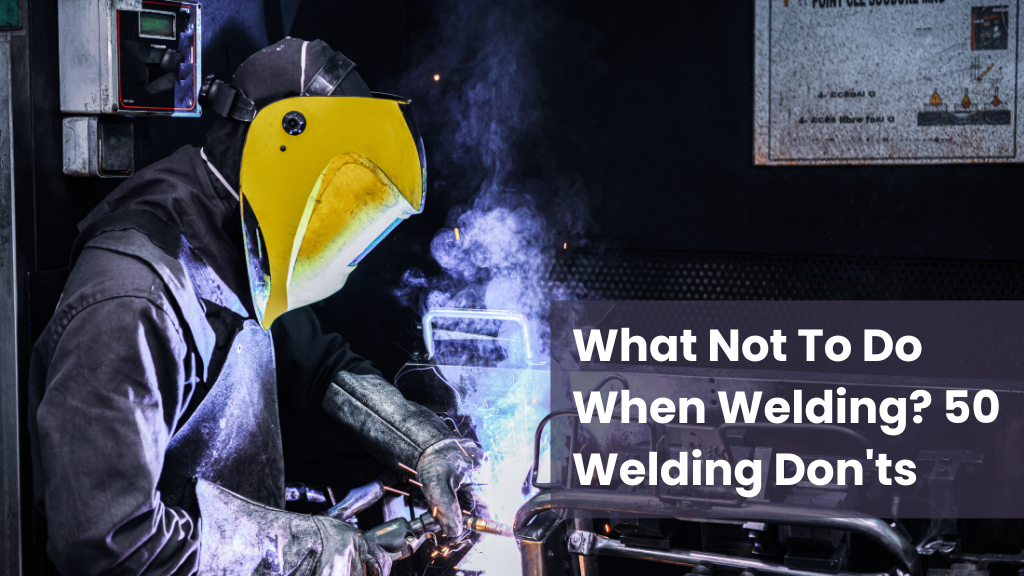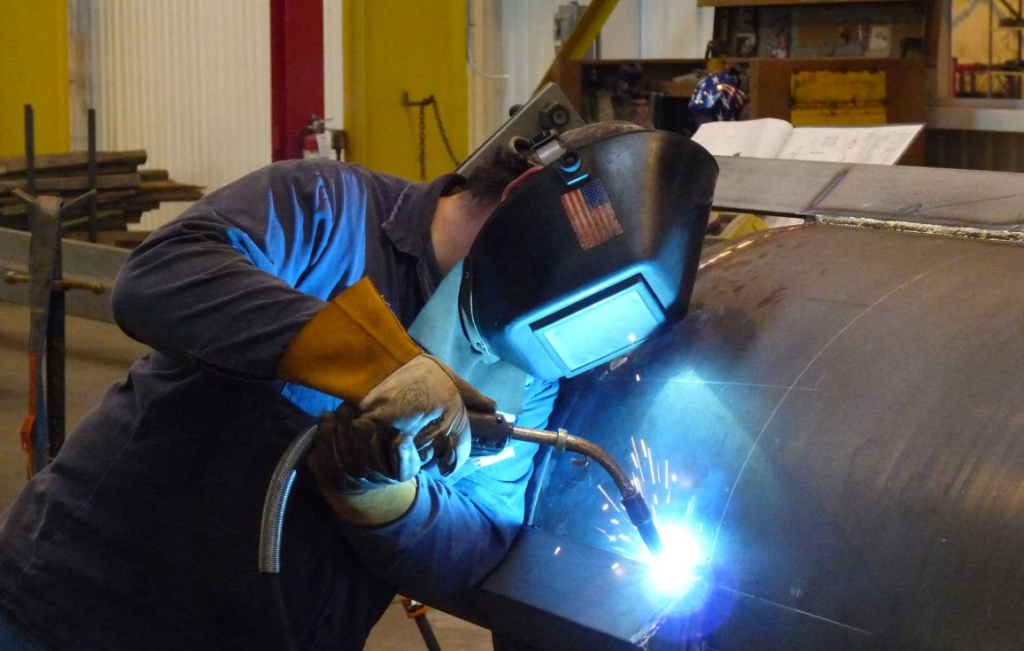As the name implies, welding involves cutting through metal and/or connecting multiple pieces of metal at extreme temperatures (often as high as 5,600 degrees Fahrenheit).
Workers must be aware of the unique hazards that welding creates due to these extreme temperatures.
It is dangerous to use an arch welder without having prior experience or education. We have compiled a list of things you shouldn’t do when welding.

214 Cases
Considered
250 Hours of Research
59 Experts Interviewed
112 Studies
Analyzed
Welding in a Poorly Ventilated Area
It’s pertinent to remember that every time you place a plasma arc on a metallic surface, chemical reactions occur that release fumes into the atmosphere.
The type of metal you are welding may release noxious or even toxic fumes, so it is imperative to weld in well-ventilated areas, otherwise you may be inhaling toxic fumes.
Not Preheating
Among the most common mistakes workers make when welding is not preheating. What is the purpose of preheating? Preheating is one of the most effective things you can do to prevent cracking.
Nothing is more frustrating than trying to weld an object and then having it crack. Preheating it before welding will reduce the risk of this happening.
Not Wearing The Appropriate Safety Gear
Wearing appropriate safety gear is another mistake to avoid when welding. People have the misconception that safety gear slows them down. However, it can save your life.
Wear a welding helmet with fitted lenses, welding gloves, a welding jacket, leather apron, and thick leather boots before using a welding arc.
Welding on unstable surfaces
When welding an object, it must rest on a flat, even, and firm surface. Don’t attempt to weld on unstable surfaces, as you’ll be at risk of injury. If necessary, use industrial-grade clamps to secure the object.
Not Cleaning or Maintaining The Arc Welder
Lastly, a common mistake made by workers is not maintaining or cleaning their devices properly. During the course of their lives, welding arcs tend to accumulate dust and dirt, just like any other powered tool. In order to keep your device in optimal condition, you need to clean it regularly.
Don’ts In Welding
- You should not overload an electrical circuit when using a MIG welding machine, as this can cause a fire hazard if done incorrectly.
- Avoid working in enclosed spaces. You could suffer a sudden death from gas inhalation.
- If you don’t wear enough eye protection when welding, you could end up permanently blind.
- Avoid using cheap ground clamps if you can. Cheap clamps will increase start times and do not provide a good connection to the ground.
- If you are using anti-splatter spray in a commercial setting, make sure it is approved.
- When a rig liner becomes clogged, poor wire feeding will result, bird nesting will occur, and burn-back could occur.
- Welders should avoid wearing short sleeves or cuffs. Sparks and hot metal could cause burns.
- Make sure your hands do not come in contact with sharp edges when opening electrode cans.
- Whenever possible, do not work in a combustible area.
- Be careful not to operate near cracks in walls and windows where sparks can escape and ignite combustible materials outside.
- Inflammable liquids and gases should not be operated in the vicinity. A single spark can trigger an explosion of huge proportions.
- It is a good idea not to work on a project where the floor is dirty. Dust and debris are excellent sources of fire.
- Welding should not be performed on containers that contain or have contained flammable materials without cleaning them properly first.
- You should keep your hoses away from any machinery and from any source of heat.
- When handling coiled hoses, be careful to avoid blockages that can lead to hose ruptures.
- Make sure cylinder caps are in place before transporting them.
- Cylinders should never be stored sideways or upside down. Make sure the capped valves are always facing upward.
- The manufacturer’s specifications should be followed when installing electrical equipment. Do not exceed the circuit load limits
- Prevent damage to welding leads by covering or suspending them from the surface.
- Ensure that your oxygen and acetylene tanks are separated by at least 20 feet.
- You can prevent a fire from spreading if you have a fire extinguisher readily accessible. If you can put out a fire quickly, you will have a better chance of preventing it from spreading.
- If you take shortcuts, you are likely to experience long (and potentially dangerous) delays as a result.
- The distance between you and other welders needs to be sufficient for you to prevent any injuries to occur as a result of working in close proximity to one another.
- In order to prevent any damage to your equipment, you should double check all your connections and couplings before you begin working, and you should take care of any loose connections as soon as possible.
- A TIG welder should not be operated without first checking to ensure that all of the settings are correct before starting to weld.
- There is no need to use an amplifier rated for a higher amp than you are able to handle with your circuit and fuse.
- Do not skimp on parts for your welder. Buy quality parts and accessories from a reputable seller.
- In order to prevent the risk of breathing in gasses produced by the welding process, it is recommended that you use a respirator while welding.
- Welders should only be operated by people who have received the proper training to safely operate them. If you are not proficient in the use of welders, you can cause yourself and others to be injured.
- When using different metals with MIG or TIG welding techniques, you might hear different sounds when working with them. It is important that you do not continue operating your rig if it does not sound right.
- Keep your welding gloves supple by putting boot grease on them and make sure that they are not torn or stiff.
- The hands that feed the filler rod should not be given mechanics gloves, as these can become so hot that they can be difficult to remove in the event that they become uncomfortable.
- When welding with tungsten electrodes, make sure to only use the size necessary for the job at hand and not larger than that as using larger electrodes may contaminate the weld and may lead to erratic arcing during the weld process.
- In order to prevent excessive shielding gas usage, it is important to use the torch gas in accordance with the torch gas recommended for each type of metal.
- It is not recommended to use gas mixtures that are not recommended by the manufacturer. This could result in serious consequences.
- A small vent hole should be left at the end of any weld project that is intended to be airtight at the end. If not, you could lose shielding gas in the weld process or risk a blown-out weld bead.
- Electric shocks can lead to serious injury or death if an improper ground connection is not established when operating a rig.
- As you use a TIG welder, it is imperative that you do not hold two bare wires in each hand. If you do, your body can become a conductor for the electrical current flowing between the wires.
- It is important not to allow the electrode to come in contact with your skin or clothing in order to avoid getting burned.
- If your gloves are wet or frayed, or if they are torn or frayed, do not wear them.
- A welder should not be operated on wet insulation at any time.
- In order to prevent damage to your ears from noisy environments and to prevent debris from entering the ear canal, you should always wear adequate hearing protection when welding.
- There are a number of risks associated with welding, including burns and injuries, so it is important that you use proper personal protective equipment.
- When welding thick aluminum castings, you should not use 100% argon. The weld bead may be flawed if you use 100 percent argon.
- You should never operate a welder without using the recommended shielding gases. Always follow the instructions given by the manufacturer.
- The best thing you can do is not to weld if you are unsure of how to do it. You do not want to ingrain a bad habit into your brain.
- In the case of thin sheet metal, the entire seam should not be welded from top to bottom. Doing so may result in the piece being distorted.
- Ensure that you do not exceed or below the required shield gas flow rate for your project in order to ensure safety.
- It is not recommended to weld a container that previously held flammable liquids without covering it with water until it is a couple of inches below the project location.
Safety In The Welding Shop: Avoiding Hazards

The welding industry faces a wide range of potential hazards in the workplace, and welders have to pay close attention to their safety at all times. Some of these potential hazards include:
Electric Shock
There have been many instances in which people have suffered serious injuries and even died as a result of a sudden discharge of electricity to their bodies.
Electrocution can occur when a welder touches two metal objects with a voltage between them, which inserts the metals into an electrical circuit, resulting in electrocution.
As the voltage increases, the current increases, resulting in a higher risk for the welder.
Exposure to Fumes and Gases
When welding, a variety of potentially harmful metals are released into the atmosphere, including aluminum, beryllium, arsenic, manganese, and lead.
Nitrogen, carbon dioxide, argon, carbon monoxide, and hydrogen fluoride are other gases that are also often released during welding.
The fumes and gases that are released by welding equipment can cause serious health problems for the workers, such as impaired speech and movement, respiratory illnesses, and even cancer, if they are overexposed to them.
Physical Injuries
Welders can experience a variety of physical hazards if they do not wear the right type of personal protective equipment (PPE), such as eye damage, cuts, burns, as well as crushing their fingers, toes and even spines.
These injuries should be taken seriously as, depending on their severity, can result in preventable disability.
Fire and Explosions
There are extreme temperatures generated in a welding arc that can cause fires and explosions if safety procedures are not followed.
There are times when sparks and spatter can come in contact with flammable materials around the work area, which can cause fires, even though the arc itself can reach temperatures as high as 10,000 degrees Fahrenheit. This is the most common cause of fires in arcs.